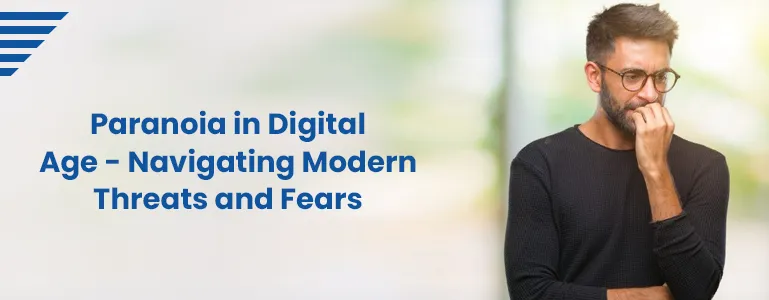Paranoia in Digital Age: Navigating Modern Threats and Fears

In the digital age, the rapid advancements in technology have brought unprecedented connectivity and convenience, but they have also given rise to new sources of anxiety and Paranoia. This blog delves into the phenomenon of paranoia in the digital age, exploring how modern threats and fears in the virtual world can impact our mental well-being. We'll discuss common triggers, the psychological mechanisms at play, and offer practical strategies to navigate these challenges.
Home Sample Collection
The Digital Landscape: A Breeding Ground for Paranoia
The omnipresence of social media, online privacy concerns, cybersecurity threats, and digital misinformation has cultivated an environment ripe for paranoia. The fear of being surveilled, having personal information compromised, or falling victim to scams can amplify feelings of suspicion and unease.
Perception vs. Reality: How the Digital World Shapes Our Perceptions
The rapid flow of information and instant access to news can distort our perception of the world, feeding into heightened paranoia. The constant exposure to sensationalized headlines and online echo chambers can lead to distorted beliefs and amplified fears.
The Psychological Mechanisms Behind Digital Paranoia
Cognitive biases, such as confirmation bias and the availability heuristic, play a significant role in digital paranoia. Our tendency to focus on information that confirms our fears and to overestimate the likelihood of negative events can perpetuate feelings of anxiety and suspicion.
Navigating Online Relationships and Trust Issues
The complexities of online relationships, where the absence of physical presence can trigger doubt and insecurity, contribute to digital paranoia. Catfishing, cyberbullying, and the fear of fake accounts strain our ability to trust others in the digital realm.
Strategies for Managing Digital Paranoia
Media Literacy Education: Developing critical media literacy skills can help individuals discern credible sources from misinformation, reducing the impact of sensationalized news on their mental well-being.
Mindful Social Media Use: Practicing mindfulness while using social media can help individuals recognize when their emotions are being manipulated by sensational content. Regular digital detoxes can also alleviate feelings of overwhelm.
Privacy Awareness: Educating oneself about online privacy settings and adopting cybersecurity measures can mitigate fears of personal data breaches, providing a sense of control over digital presence.
Balanced Information Consumption: Cultivating a habit of seeking out diverse perspectives and reliable sources can prevent the reinforcement of paranoid beliefs and provide a more accurate view of the world.
Open Dialogue and Support: Engaging in open discussions about digital fears with trusted friends, family members, or mental health professionals can alleviate isolation and provide a sense of validation.
Conclusion
In an era characterized by rapid technological change, paranoia in the digital age is a real concern that affects many individuals. As we navigate the challenges of a hyper-connected world, it's essential to be aware of the triggers, psychological mechanisms, and strategies that can help us maintain our mental well-being. By cultivating media literacy, practicing mindfulness, and fostering open communication, we can harness the benefits of the digital age while mitigating the risks of digital paranoia.
Frequently Asked Questions
What is digital paranoia, and how does it differ from general paranoia?
Digital paranoia refers to the heightened sense of suspicion, anxiety, and fear that can arise from online activities and interactions. It's distinct from general paranoia as it's often triggered by concerns related to online privacy, cybersecurity threats, and misinformation.
What are some common triggers of paranoia in the digital age?
Paranoia in the digital age can be triggered by concerns over online surveillance, data breaches, cyberbullying, online scams, and the spread of misinformation. These triggers can lead to heightened feelings of suspicion and anxiety.
How does the digital world shape our perceptions and contribute to paranoia?
The digital world exposes us to a constant stream of information, some of which may be sensationalized or biased. This can lead to distorted perceptions of reality, fueling feelings of anxiety and paranoia as we struggle to differentiate between genuine threats and sensational content.
What are cognitive biases, and how do they contribute to digital paranoia?
Cognitive biases are mental shortcuts that can lead us to make irrational judgments. In the context of digital paranoia, confirmation bias (favoring information that confirms our fears) and the availability heuristic (overestimating the likelihood of negative events) can amplify anxious thoughts.
How can I manage my fears of online privacy and cybersecurity threats?
Educating yourself about online privacy settings, adopting cybersecurity best practices, and staying informed about potential threats can empower you to take control of your digital presence. By implementing these measures, you can alleviate fears of personal data breaches and unauthorized access.
How can I balance my online relationships and trust issues in the digital world?
Building trust in online relationships requires careful discernment. Being cautious about sharing personal information, verifying the identity of individuals, and engaging in open communication can help you navigate trust issues and mitigate feelings of paranoia.
What practical strategies can I use to navigate digital paranoia?
Strategies include practicing media literacy to identify reliable sources, engaging in mindful social media use to avoid emotional manipulation, seeking diverse perspectives, and having open conversations about digital fears with supportive individuals. Balancing information consumption and taking breaks from digital platforms are also effective tactics.
Book Appointment
Our Locations Near You in Hyderabad
3KM from Banjara Hills
1.9KM from Yusufguda
3KM from Madhura Nagar
5KM from Shaikpet




